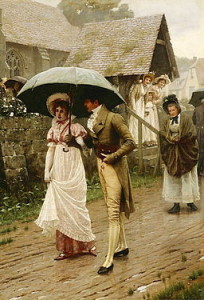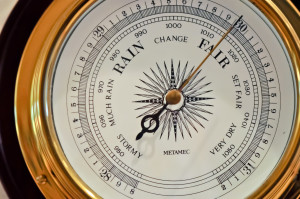Kristi here. I live in Atlanta, Georgia, unofficially and unaffectionately nicknamed Hotlanta. We have two seasons here, winter and summer. Maybe a week of spring or fall thrown in just to make you hope.
While we are accustomed to hot summers, this year it’s been worse than normal. For most of the United States, higher than normal temperatures have been an issue. With the mixed blessing of weather forecasting we can know that this heat isn’t going anywhere anytime soon.

“A Wet Sunday Morning” by Edmund Blair Leighton Photo: Wikimedia Commons
With this expansive summer heat comes the ever present summer rain shower. I have an app on my phone that can tell me whether or not I can expect rain on a given day and what time it’s going to appear, almost down to the minute.
People in the Regency didn’t have the blessing of their local Channel 5 meteorologist or the Weather Channel app on their smart phone. That doesn’t mean that they were unable to make educated forecasts about the day’s weather.
By the time of the Regency, barometers had become a fairly common tool for the upper and middle class. Barometers use a tube filled with liquid to measure the pressure of the atmosphere. Low pressure meant a higher likelihood of rain and clouds whereas high pressure was usually an indicator of clear sunshine.
Weather forecasting is a notoriously fickle thing. Even the best equipped meteorologist today gets the extended forecast wrong most of the time. This was no different for the amateur forecaster in England. The barometric pressure had an average range of 3 inches. As the tools became used by more and more people, adjustments were made to the barometer’s design that made it easier to read the small variations in pressure.

Designers and furniture makers also got into the barometer business, making the tools into decorative pieces for the home and adding thermometers, clocks, or a hygrometer.
The hygrometer used an oat fiber to indicate the humidity in the air.
Barometer makers also created a new way to read the level, creating a wheel gauge that would allow people to more easily detect the level of the mercury. The wheel had a needle that pointed to the pressure level. It had a tendency to stick requiring people to tap lightly on the glass to attain an accurate reading.
While I’m very grateful for the accuracy of Doppler radar and I wouldn’t trade the ability to know how my beach weekend is going to look, I like that so many people acquired a basic knowledge of atmospheric science in order to make their own predictions about the weather.
What is your favorite scientific tool that is now or once was part of everyday life?
Originally posted 2013-07-03 10:00:00.
Comments are closed.